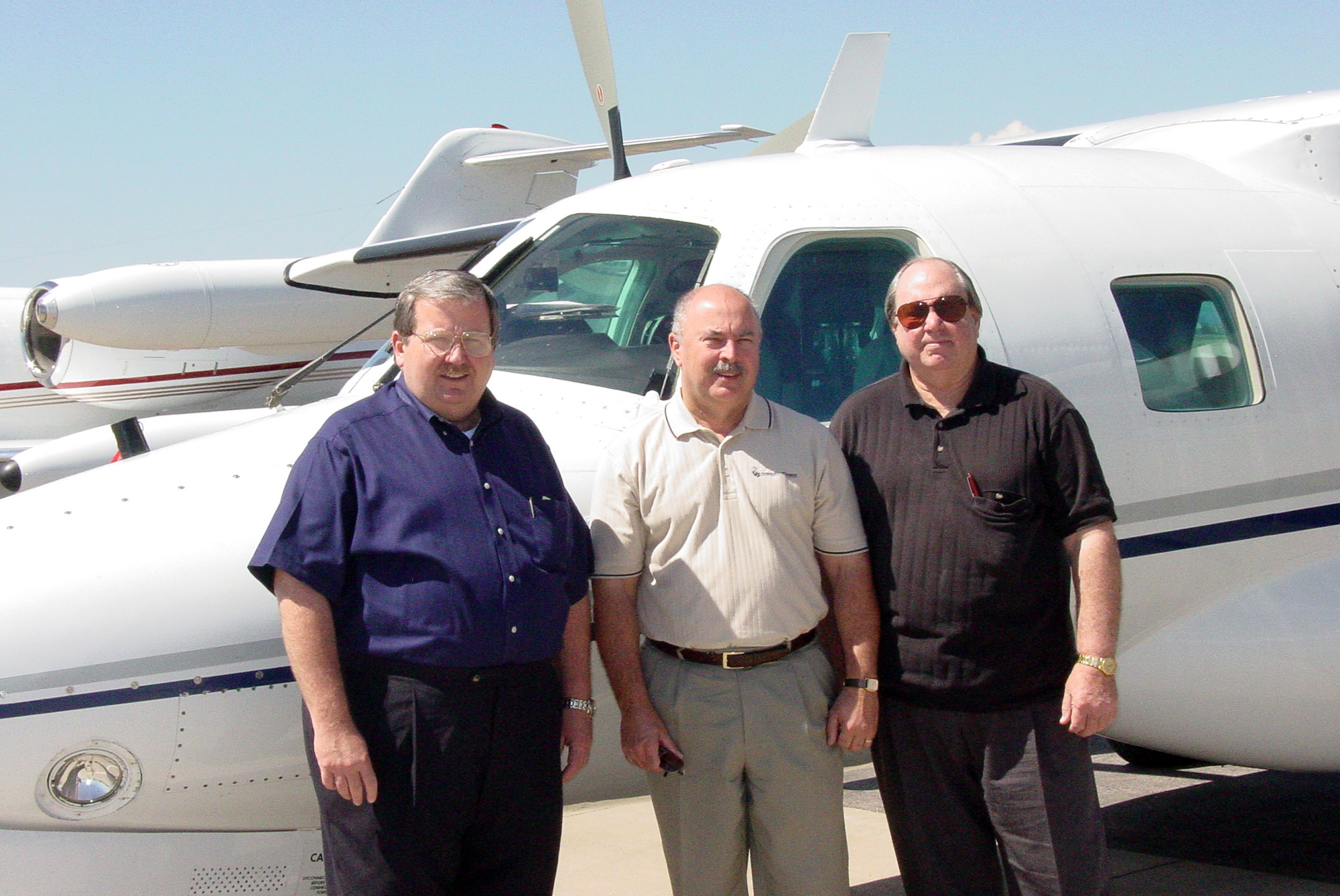By S. Clayton Moore
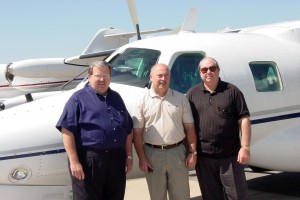
Tom Berscheidt, president of Turbine Aircraft Services, and Pat Cannon, vice president, traveled to Centennial Airport with Ralph Sorrells, deputy general manager of Mitsubishi Heavy Industries America, to champion the reliability of the MU-2B.
Whether people love it or hate it, everyone seems to have a strong reaction to the Mitsubishi MU-2B these days.
Lately, the most vocal group has been the aircraft’s critics. After more than 200 accidents and many fatal crashes, some detractors are questioning the logic in allowing the MU-2B to remain in flight. Opponents of the MU-2B range from victims’ families to Representative Tom Tancredo (R-Colo.), who has actively lobbied the Federal Aviation Administration to ground the airplane.
It’s a surprising and unfortunate twist for an aircraft that has long had its admirers. Designed as a light twin turboprop transport, the first models of Mitsubishi’s popular post-war aircraft rolled off the assembly line in 1956. In 1965, the company established a production facility for the MU-2 in San Angelo, Texas, creating a connection to the Lone Star State that is still strong today.
The subsequent production aircraft, designated the MU-2B, were delivered with Garrett TBE331 engines that remained standard on all later models. Capable of a maximum speed of more than 300 miles per hour and a range of more than 1,200 miles, the plane has been a popular choice for Part 135 charter, cargo and air ambulance operations.
Regrettably, a rash of recent accidents has put the airplane in a bad light. Of the 800 plus aircraft built between 1967 and 1985, more than 200 have been involved in incidents or fatal accidents, according to National Transportation Safety Board records.
Although more than 400 MU-2Bs are still in active service, a significant number of accidents in 2004 and 2005 have elevated the aircraft’s profile, but not in a good way. MU-2B pilots, supporters and user groups say the aging workhorse of an airplane has gotten a bad rap.
“I’m a huge believer in this airplane,” said Earle Martin, an MU-2B operator who flies part 135 charter for his Houston-based carrier, Mid-Coast Air Charter. “People have their own agendas, but it seems like those folks who want to knock the MU-2B are the ones who don’t have any experience in them.”
Crunching the numbers
The accident statistics seem startling at first glance, but former NTSB investigator Greg Feith, who now consults on aviation safety for both national and international companies, believes the numbers have a different lesson to teach. At Mitsubishi’s request, Feith performed a safety review of the MU-2B series of aircraft, during which he examined the record in great detail.
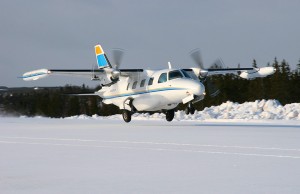
The MU-2B’s sturdiness and reliability make it ideal for use in rugged country or at smaller airports with short runways.
“I don’t believe statistics tell the entire story, so I pulled all 212 incidents in the NTSB database,” Feith said. “I dissected every one of them, not just the probable cause statements, to arrive at the common denominators in the contributing factors of these accidents. The common factors ended up being not in the airplane but in the human interactions between the pilot and the aircraft. They wound up being in the areas of basic airmanship, aeronautical decision-making and lack of airspeed discipline.”
Feith also says that unusual circumstances can distort the statistics. While the MU-2B is often compared to similarly sized aircraft such as the King Air, he believes that such comparisons can often generate misleading statements, such as the FAA’s claim in 2005 that the MU-2B’s accident rate is twice as high as similar twin-turboprop airplanes.
“That’s not fair,” Feith said. “You have to compare apples to apples. The King Air is almost never used for cargo, and the MU-2B is used for cargo a lot. The environments and pilots that they’re comparing the airplane to are totally different.”
In other cases, Feith found several examples of what he calls “one-off” events, such as a 2004 fatal accident in which a courier walked into the rotating propeller of an engine.
“Statistics can skew the perspective on the airplane, especially when you talk about fatal accidents,” he said. “I personally believe that the lack of tactile skill development is the key. If pilots get the right training, they not only get the tactile training but also the recognition cues if something should go wrong.”
A show of faith
That doesn’t make it any easier for pilots like Phil Petrik of Richland Aviation in Sydney, Mont. While he says he feels a real “mystique” for the MU-2B, he also gets hassled a lot for its reputation.
“Every time I walk through the door of an FBO, I know I have to steel myself against the comments,” Petrik said. “You hear it all the time: ‘Oh, look, an MU-2B, the Kill You, Too.’ But every time you ask those guys if they’ve ever been in an MU-2B, they have no hours at all in the aircraft.”
To combat the aircraft’s negative reputation, MU-2B owners and operators around the country have formed user groups and maintain a robust connection with Mitsubishi, which continues to strongly support the MU-2B, both directly and through American partners like Turbine Aircraft Services, Inc., in San Angelo, where most of the planes were manufactured.
“It’s easy to support the airplane, because it’s a great, reliable plane,” said Tom Berscheidt, president of Turbine Aircraft Services. “Mitsubishi’s approach is that they don’t wait to have problems; they’re very proactive. And the community of MU-2B owner-operators is a very tight group. They share information all the time, all for the benefit of safety and improving operations. This is a product that Mitsubishi has made, and they’re a big player in aerospace worldwide. They want to take care of the product that they produce.”
For pilots like Martin, who has more than 7,000 hours in the aircraft, the MU-2B serves as an outstanding choice for his business.
“Once they get in the airplane, my customers love it and want to come back to it again and again,” he said. “It’s a very well-built, sturdy airplane. One of the cases where the sturdiness comes in handy is when you’re landing on a short runway—what we jokingly refer to as a ‘carrier landing.’ You wouldn’t abuse the MU-2B on purpose, of course, but if you really have to plant it on a short runway to make the landing and stop, you can land it hard and know you’re not going to hurt it. The MU-2B will take whatever you can throw at it and keep flying.”
Back in Montana, Phil Petrik finds that the MU-2B provides a good solution to the Big Sky Country’s harsh weather conditions and rugged rural airfields.
“I really like the economy, the engines, the speed and the range,” Petrik said. “I can go in and out of 2,000-foot runways without any trouble or concern. I can hit that 300 knot mark easily and still have a decent range. It’s basically a Lear 24 with propellers. You have all the jet features, and yet, it’s still a turboprop.”
Dispelling the myths
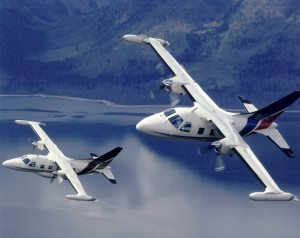
Enthusiasts of the MU-2B, like the twin examples shown here, say the aircraft is one of the best-handling general aviation twin turboprops ever manufactured.
In his report, Feith has tried to analyze and address some of the perceptions about the MU-2B as a “dangerous” aircraft.
“There were a lot of ideas out there about this aircraft that just aren’t valid,” he said. “Unfortunately, we have a very litigious society, and you can always find an ‘expert’ who claims that the aircraft will behave a certain way under certain conditions.”
Among those concerns are popular conceptions that the MU-2B has high wing loading during all phases of flight and that the use of ailerons (versus spoilers) could negatively affect the operations of the aircraft. Among those concerns is a popular conception that because of the MU-2B’s high wing loading, the use of ailerons (versus spoilers) could negatively affect the operations of the aircraft.
“One of the myths is that the wing loading inhibits the controllability of the airplane,” Feith said. “That’s simply not true. It’s true that the MU-2B has high wing loading—in cruise flight when the flaps are up. That’s a good thing because it makes it more stable in turbulent weather.”
Another popular claim is that if an MU-2B loses an engine during takeoff or landing, it’s all over. Feith and Pat Cannon, vice president of Turbine Aircraft Services, put that theory to the test by actually running their own tests and videotaping the results to show to Mitsubishi owner-operators, and if needed, critics of the airplane. Initially, they equipped an MU-2B with three video cameras and then shut down an engine during those operations.
“This is with the engine out,” Feith said, rolling the video, which shows the aircraft handily recovering. “The perception is that it’s instant death. In fact, it’s very controllable, as long as you fly it by the numbers and, like any other airplane, use the rudder to get rid of the asymmetrical input. You don’t want the airplane flying sideways, because it creates a lot of drag and reduces airspeed, which is life.”
Another story (and several lawsuits) claims the MU-2B is vulnerable to icing conditions. The MU-2B is actually one of the few aircraft to undergo FAA testing for icing conditions, flying behind super-cooled icing spray expelled in flight by a water-spray tanker. During that test, conducted in the 1990s, the MU-2B was fully qualified for known icing conditions. Mitsubishi has recently developed an icing awareness video that other manufacturers are now looking at duplicating.
“Everybody thinks that if you take the MU-2B into icing conditions, you’re in big trouble, but that’s not right,” Petrik said. “I’ve flown in a lot of airplanes, and this one flies very well in ice.”

Outfitted with Honeywell (Garrett) TPE331-10 turboprop engines, the Mitsubishi MU-2B will cruise at 315 knots at 20,000 feet. A number of accidents have given the plane the reputation of being dangerous to fly.
Perhaps no one is a bigger supporter than Pat Cannon, who was at the stick during many of the tests conducted in assembling Feith’s safety report.
“This aircraft isn’t difficult to fly, but it is a complex turboprop airline,” Cannon said. “I have about 9,000 hours in the MU-2B, and I’ve had a chance during my flying career to experience almost anything you can do to this airplane. I’ve flown inside and outside the envelope. I’ve had an engine failure on takeoff with the aircraft. I’ve not experienced a lot of actual emergencies, but I’ve certainly trained for them. I would put my family in the MU-2B over any other airplane out there.”
Training, training, training
So why the recent wave of crashes? Both experts and other owner-operators believe a combination of factors contributed to the MU-2B incidents. They include a prior void in the training requirements regulated by the FAA and an increase in the ranks of unqualified pilots gaining time in the airplane.
“Recently, we’ve had a rash of accidents that have come out of the cargo business,” Cannon admitted, referring to the proliferation of low-budget canceled check operations and all-night freight pilots who sometimes utilize the economical MU-2B. “We feel that a lot of these accidents came from a lack of proper training. Some businesses were bringing in some aggressive young guys—not all of them, but a few have—and the pilots just weren’t up to flying this airplane.”
The problems are obvious to longtime MU-2B owners like Martin, who frequently sees problem pilots flying his favorite aircraft.
“In our airplanes, two types of people are trouble,” Martin said. “You get the owner who purchases the airplane because he can find an old one on the cheap. He might barely have the down payment, but suddenly he’s in this aircraft that still has all the training and maintenance requirements you’d expect from a twin turboprop. But he doesn’t have the money to keep it up. We’ve also seen some accidents from pilots with big egos, who look at the MU-2B like it’s a test of their manhood. The two types of pilots to look out for are the ones who don’t have the money and the ones with the big heads.”
Even professionals working directly for Mitsubishi admit that some pilots just don’t have the right stuff to fly the MU-2B.
“You see a lot of accidents with high-time pilots as well as low-time pilots,” observed Ralph Sorrells, deputy general manager of Mitsubishi Heavy Industries America. “The guy in the middle is safe in most cases. He’s still learning; he’s training and hasn’t become complacent yet. That doesn’t always apply when you get the airline pilot who thinks he has the world by the tail just because he’s been flying 747s. That guy still needs to go to proper training on this aircraft and respect what it will do.”
It’s a strongly held belief in the MU-2B community that training could solve a lot of problems. Although the annual training recommended by Mitsubishi and currently under review by the FAA has long been available through outfits like Florida-based SimCom and other professional training providers, getting MU-2B pilots to attend is another matter.
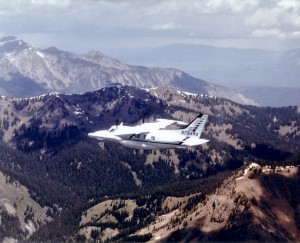
Although some detractors claim the MU-2B is unreliable in icing conditions, the aircraft passed a significant icing test. It was flown in freezing conditions, following behind a tanker that sprayed it with water, during an FAA test conducted in the 1990s.
“The folks who fly the MU-2B have always had the ability to get training,” Sorrells said. “The training is out there, but the discipline is really incumbent upon the operator. We haven’t seen another accident in Australia since they revisited their training issue. In Europe, they have a type rating style of training, and they haven’t seen the level of accidents that we have here in America. It comes out loud and clear to me that this is a training issue. We need consistent training programs that are repetitive—similar to what we see in those countries.”
Many owner-operators such as Martin and Petrik agree wholeheartedly.
“I did my training in Salina with Professional Flight Training,” Petrik recalled. “I was very pleased that all the things I discovered and learned on my own were right in line with the guidelines I was taught in school, but that doesn’t mean I didn’t learn a lot. There’s nothing really challenging about flying the MU-2B, but it would be if you didn’t know what you were doing. Training, training, training. That’s the key.”
Mitsubishi Heavy Industries has long requested that the FAA require formal training in the MU-2B, and it looks like that will soon come to pass. The Flight Standards Board convened by the government body recently recommended airline-quality Level E initial training for new pilots and Level C annual recurrent training for more experienced owner-operators.
“I was involved in putting together the training program, and it’s in final review at the FAA,” Feith said. “That will go immediately to the 135 charter pilots. The following Federal Air Regulation will call for mandatory training at several different levels, depending on the pilot. It requires a little more flying of the aircraft and a little more detail in the training program.”
Not everyone will pass, and for the professionals who love the MU-2B, that’s OK.
“We’re training these people to a specific level, and their proficiency will be examined to those standards,” Cannon said. “We may find pilots who can’t perform to those standards, and who won’t qualify to fly the aircraft. That may be a good thing.”
Martin, who also deals regularly with the same line of questioning Petrik faces at the FBOs he utilizes, simply wants others to be more educated about the aircraft.
“It seems like it’s always people who have heard how bad they are from other people, neither of which has ever been in an MU-2B,” Martin said. “We don’t tell people to ignore the accidents. Go read the accident reports to see what kind of problems pilots have had in this airplane, so you can deal with them. If you’re prepared to deal with those issues, you should have no problems.”











